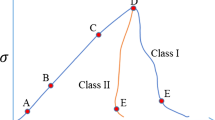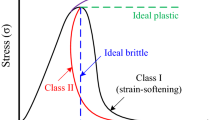Abstract
To systematically study the influence of axial- and lateral-strain-controlled loadings on the strength and post-peak deformation behaviors of brittle rocks, four types of rocks (marble, sandstone, granite, and basalt) are tested under uniaxial and triaxial compressions, using a brittle hard rock testing system named Stiffman with high loading system stiffness. The test results show that the post-peak stress–strain curves of rock specimens under axial-strain-controlled loading are Class I, while those under lateral-strain-controlled loading are mostly Class II when the confining pressure is low. As confining pressure increases, the stress–strain curves change to Class I. Compared with that under lateral-strain-controlled loading, the failure of rock under axial-strain-controlled loading is more intense, the peak strength is higher, and the residual strength is lower. It is demonstrated that Class II post-peak stress–strain curves obtained by lateral-strain-controlled loading are caused by the unloading of the actuator in response to the servo-control system to keep the lateral strain rate constant. In the post-peak deformation stage, large dilation occurs, which leads to a sudden increase of the lateral strain rate; in order to keep the lateral strain rate at the set value under lateral-strain-controlled loading, the servo-control system must force the actuator to unload. When rock dilation occurs in the pre-peak deformation stage, unloading can occur before the peak strength, resulting in a decrease of peak strength compared with the peak strength obtained by axial-strain-controlled loading. It is found that the more brittle and dilatant a rock, the earlier the unloading of the actuator is, and the larger the peak strength decreases and the more obvious the Class II curve is.


















Similar content being viewed by others
References
Akdag S, Karakus M, Nguyen GD, Taheri A, Bruning T (2019) Evaluation of the propensity of strain burst in brittle granite based on post-peak energy analysis. Undergr Space 6:1–11
Bieniawski Z (1966) Mechanism of rock fracture in compression. Rock Mechanics Division, National Mechanical Engineering Research Institute, Council for Scientific and Industrial Research, South Africa
Bieniawski Z (1967) Mechanism of brittle fracture of rock, Parts I, II and III. Int J Rock Mech Min Sci 4:395–430
Bieniawski Z, Bernede M (1979) Suggested methods for determining the uniaxial compressive strength and deformability of rock materials: part 1. Suggested method for determining deformability of rock materials in uniaxial compression. Int J Rock Mech Min Sci Geomech Abstr 16:138–140
Bieniawski Z, Denkhaus H, Vogler U (1969) Failure of fractured rock. Int J Rock Mech Min Sci 6:323–341
Brady BHG, Brown ET (1993) Rock mechanics for underground mining. Springer, Amsterdam
Brown E (1981) Suggested methods for determining the uniaxial compressive strength and deformability of rock materials. Rock characterisation testing and monitoring—ISRM suggested methods. Pergamon Press, Oxford
Cai M (2008) Influence of stress path on tunnel excavation response—numerical tool selection and modeling strategy. Tunn Undergr Space Technol 23:618–628
Cai, M, Hou, PY, Zhang, XW, Feng, XT (2021). Post-peak stress–strain curves of brittle hard rocks under axial-strain-controlled loading. Int J Rock Mech Min Sci 147:104921
Cai M, Kaiser P (2018) Rockburst support reference book—volume I: rockburst phenomenon and support characteristics. Laurentian University, Sudbury
Cai M, Kaiser P, Uno H, Tasaka Y, Minami M (2004) Estimation of rock mass deformation modulus and strength of jointed hard rock masses using the GSI system. Int J Rock Mech Min Sci 41:3–19
Cai M, Kaiser P, Tasaka Y, Minami M (2007) Determination of residual strength parameters of jointed rock masses using the GSI system. Int J Rock Mech Min Sci 44:247–265
Chen S, Guo W, Liu J, Yin L (2010) Experiment on formation mechanism of rock class II curve. J China Coal Soc 35:54–58
Cook N (1965) The failure of rock. Int J Rock Mech Min Sci Geomech Abstr 2:389–403
Cook N, Hojem J (1966) A rigid 50-ton compression and tension testing machine. J South Afr Mech Eng 1:89–92
Drucker D (1959) A definition of stable inelastic material. J Appl Mech 26:101–195
Fairhurst C, Hudson J (1999) Draft ISRM suggested method for the complete stress–strain curve for intact rock in uniaxial compression. Int J Rock Mech Min Sci 36:279–289
Feng X (2017) Rockburst: mechanisms, monitoring, warning, and mitigation. Butterworth-Heinemann, Oxford
Gao F, Kang H (2017) Experimental study on the residual strength of coal under low confinement. Rock Mech Rock Eng 50:285–296
Ge X, Zhou B (1992) The servo-controlled rock mechanics testing machine based on the self-adaptable principle and it’s significance for some research field of rock mechanics. Rock Soil Mech 13:8–13
Ge X, Zhou B, Liu M (1992) New insights into the post-peak characteristics of rocks. China Min Mag 2:60–63
He C, Okubo S, Nishimatsu Y (1990) A study of the class II behaviour of rock. Rock Mech Rock Eng 23:261–273
Hoek E, Brown ET (1997) Practical estimates of rock mass strength. Int J Rock Mech Min Sci 34:1165–1186
Hoek E, Carranza-Torres C, Corkum B (2002) Hoek–Brown failure criterion-2002 edition. Proc NARMS-Tac 1:267–273
Hojem J, Cook N, Heins C (1975) A stiff, two maganewton testing machine for measuring the worksoftening behaviour of brittle materials. J S Afr Mech Eng 25:250–270
Hudson J, Harrison J (2000) Engineering rock mechanics: part 1: an introduction to the principles. Elsevier, Pergamon
Hudson J, Brown ET, Fairhurst C (1971) Optimizing the control of rock failure in servo-controlled laboratory tests. Rock Mech 3:217–224
Hudson J, Crouch S, Fairhurst C (1972) Soft, stiff and servo-controlled testing machines: a review with reference to rock failure. Eng Geol 6:155–189
Joseph T (2002) Estimation of the post-failure stiffness of rock. Dissertation, University of Alberta
Kawakata H, Cho A, Kiyama T, Yanagidani T, Kusunose K, Shimada M (1999) Three-dimensional observations of faulting process in Westerly granite under uniaxial and triaxial conditions by X-ray CT scan. Tectonophysics 313:293–305
Keedy DA, Volungis RJ, Kawai H (1960) The use of an instron testing machine for the determination of stress and strain-optical coefficients. Universtity of Massachusetts Amherst, Amherst
Kovari K, Tisa A, Einstein H, Franklin J (1983) Suggested methods for determining the strength of rock materials in triaxial compression: revised version. Int J Rock Mech Min Sci Geomech Abstr 20:285–290
Labuz JF, Biolzi L (1991) Class I vs class II stability: a demonstration of size effect. Int J Rock Mech Min Sci Geomech Abstr 28:199–205
Labuz JF, Zang A (2012) Mohr–Coulomb failure criterion. Rock Mech Rock Eng 45:975–979
Mishra B, Nie D (2013) Experimental investigation of the effect of change in control modes on the post-failure behavior of coal and coal measures rock. Int J Rock Mech Min Sci 60:363–369
Okubo S, Nishimatsu Y (1985) Uniaxial compression testing using a linear combination of stress and strain as the control variable. Int J Rock Mech Min Sci Geomech Abstr 22:323–330
Okubo S, Nishimatsu Y, He C (1990) Loading rate dependence of class II rock behaviour in uniaxial and triaxial compression tests—an application of a proposed new control method. Int J Rock Mech Min Sci Geomech Abstr 27:559–562
Paulding BW (1965) Crack growth during brittle fracture in compression. Dissertation, Massachusetts Institute of Technology
Peng J, Cai M (2019) A cohesion loss model for determining residual strength of intact rocks. Int J Rock Mech Min Sci 119:131–139
Rummel F, Fairhurst C (1970) Determination of the post-failure behavior of brittle rock using a servo-controlled testing machine. Rock Mech 2:189–204
Sano O, Terada M, Ehara S (1982) A study on the time-dependent microfracturing and strength of Oshima granite. Tectonophysics 84:343–362
Saroglou H, Tsiambaos G (2008) A modified Hoek–Brown failure criterion for anisotropic intact rock. Int J Rock Mech Min Sci 45:223–234
Singh M, Raj A, Singh B (2011) Modified Mohr–Coulomb criterion for non-linear triaxial and polyaxial strength of intact rocks. Int J Rock Mech Min Sci 48:546–555
Singh M, Samadhiya N, Kumar A, Kumar V, Singh B (2015) A nonlinear criterion for triaxial strength of inherently anisotropic rocks. Rock Mech Rock Eng 48:1387–1405
Stavrogin A, Tarasov B (2001) Experimental physics and rock mechanics. CRC Press, Boca Raton
Stavrogin A, Tarasov B, Shirkes O, Pevzner E (1981) Strength and deformation of rocks before and after the breakdown point. Sov Min Sci 17:487–493
Ulusay R, Hudson J (2007) Suggested methods for determining the uniaxial compressive strength and deformability of rock materials. In: Ulusay R, Hudson J (eds), The complete ISRM suggested methods for rock characterization, testing and monitoring: 1974–2006. ISRM Turkish National Group and the ISRM, Ankara, Turkey, pp 151–156
Vogler U, Stacey T (2016) The influence of test specimen geometry on the laboratory-determined Class II characteristics of rocks. J S Afr Inst Min Metall 116:987–1000
Wawersik WR, Brace WF (1971) Post-failure behavior of a granite and diabase. Rock Mech 3:61–85
Wawersik WR, Fairhurst C (1970) A study of brittle rock fracture in laboratory compression experiments. Int J Rock Mech Min Sci Geomech Abstr 7:561–575
Wawersik WR (1968) Detailed analysis of rock failure in laboratory compression tests. Dissertation, University of Minnesota
Wong LNY, Meng F, Guo T, Shi X (2020) The role of load control modes in determination of mechanical properties of granite. Rock Mech Rock Eng 53:539–552
Xu T, Tang CA, Zhang Z, Zhang YB (2003) Theoretical, experimental and numerical studies on deformation and failure of brittle rock in uniaxial compression. J Northeast Univ (nat Sci) 24:3164–3169
You M (1998) Unstable failure of rock sample under uniaxial compression and loading performance of testing machine. Rock Soil Mech 19:43–49
You M (2007) Mechanical properties of rock. Geological Press, Bei**g
Zhang H, Li CC (2019) Effects of confining stress on the post-peak behaviour and fracture angle of Fauske marble and Iddefjord granite. Rock Mech Rock Eng 52:1377–1385
Zhang X, Yang C, Zhang J, Ren J (2013) Experimental study of mechanical behaviour of deep gneiss in Hongtoushan copper mine. Chin J Rock Mech Eng Geol 32:3228–3237
Zhang X, Feng X, Kong R, Wang G, Peng S (2017) Key technology in development of true triaxial apparatus to determine stress–strain curves for hard rocks. Chin J Rock Mech Eng Geol 36:2629–2640
Zhang S, Wu S, Chu C, Guo P, Zhang G (2019) Acoustic emission associated with self-sustaining failure in low-porosity sandstone under uniaxial compression. Rock Mech Rock Eng 52:2067–2085
Zhao X, Cai M (2010a) Influence of plastic shear strain and confinement-dependent rock dilation on rock failure and displacement near an excavation boundary. Int J Rock Mech Min Sci 47:723–738
Zhao X, Cai M (2010b) A mobilized dilation angle model for rocks. Int J Rock Mech Min Sci 47:368–384
Zhao X, Cai M, Wang J, Ma L (2013) Damage stress and acoustic emission characteristics of the Beishan granite. Int J Rock Mech Min Sci 64:258–269
Zheng H, Li C (1997) Analysis principle and application of brittle-plastic rock mass. Chin J Rock Mech Eng 16:8–21
Zheng H, Ge X, Li C (1998) Reply to “Discussion on complete stress–strain curves of rocks uniaxial compression test.” Chin J Rock Mech Eng 17:107–108
Acknowledgements
This work was financially supported by the National Natural Science Foundation of China under Grant no. 51974061, 42177169, the Liao Ning Revitalization Talents Program (XLYC1801002), the National Key R&D Program of China (2018YFC0407006), the 111 project under Grant no. B17009, and the Fundamental Research Funds for the Central Universities (N2001003, N2001001).
Author information
Authors and Affiliations
Corresponding author
Ethics declarations
Conflict of interest
The authors wish to confirm that there are no known conflicts of interest associated with this publication and there has been no significant financial support for this work that could have influenced its outcome.
Additional information
Publisher's Note
Springer Nature remains neutral with regard to jurisdictional claims in published maps and institutional affiliations.
Appendix
Appendix
The mechanical properties of marble, sandstone, granite, and basalt with axial- and lateral-strain-controlled loadings under different confining pressures are shown in Tables 4 and 5, respectively.
Rights and permissions
About this article
Cite this article
Hou, P.Y., Cai, M., Zhang, X.W. et al. Post-peak Stress–Strain Curves of Brittle Rocks Under Axial- and Lateral-Strain-Controlled Loadings. Rock Mech Rock Eng 55, 855–884 (2022). https://doi.org/10.1007/s00603-021-02684-9
Received:
Accepted:
Published:
Issue Date:
DOI: https://doi.org/10.1007/s00603-021-02684-9




